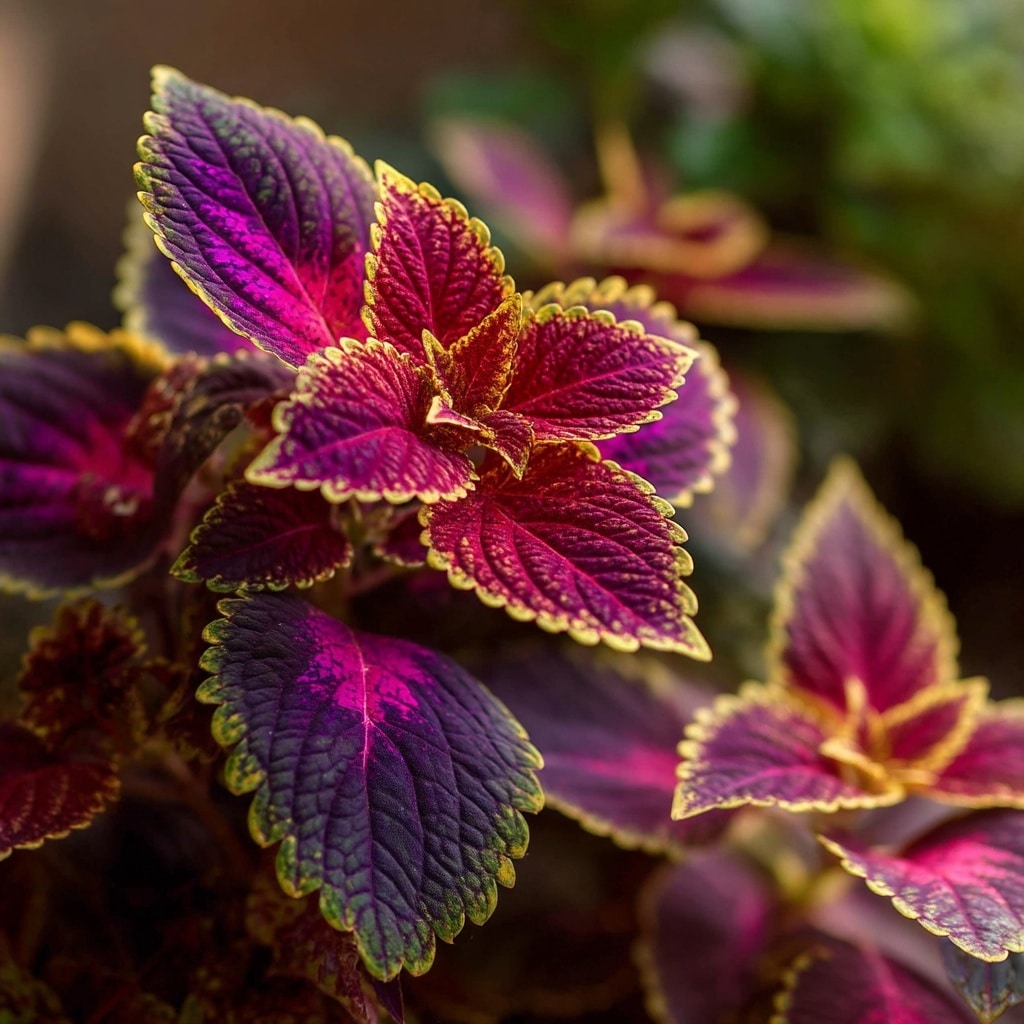Coleus plants are among the most vibrant foliage choices you can add to your garden or indoor plant collection. With their stunning leaves in shades of lime green, burgundy, purple, and even fiery orange, coleus plants bring bold color where blooms may be lacking. These tropical perennials, often grown as annuals in cooler climates, belong to the mint family and are loved for their fast growth and eye-catching patterns.
Whether you’re growing coleus in containers, hanging baskets, or as a border plant, their versatility and low-maintenance needs make them a favorite for both beginner and experienced gardeners. In this guide, you’ll learn exactly how to keep your coleus thriving, from li
Table of Contents
Coleus Plant Care
Caring for coleus plants is simple once you understand their basic needs. These colorful ornamentals grow quickly and adapt well to both garden beds and container setups. Because of their vigorous growth, they’re perfect for filling in empty spots in your landscape or adding dramatic flair to patios and balconies.
One of the biggest appeals of coleus plants is how forgiving they are. They respond quickly to trimming, tolerate a variety of light conditions, and are easy to propagate. Whether you’re growing them indoors or outdoors, a few key care steps will keep your coleus healthy and bold all season long.
When planting, spacing them closely creates a full, lush effect—perfect for ground cover or a striking display in window boxes. Regular watering, attention to soil quality, and temperature awareness go a long way in keeping your coleus looking its best.
Light Requirements

Most coleus plants thrive in partial shade, where their foliage can fully develop its rich, saturated color without scorching. Dappled sunlight or morning sun with afternoon shade works best for many varieties, especially those with darker leaves.
However, plant breeders have developed several sun-tolerant cultivars that can handle more direct light. If you’re planting a sun-loving type, make sure to introduce it gradually to brighter conditions to avoid leaf burn.
For indoor coleus, place pots near bright, indirect light. Avoid placing them in south-facing windows without sheer curtains, as the intense sun may fade their colors or damage tender leaves. If the leaves appear washed out or scorched, reduce light exposure.
Keep in mind: the leaf color of coleus plants can vary depending on the amount of light they receive. Adjust lighting based on the specific variety you’re growing to bring out the best in their foliage.
Watering Needs
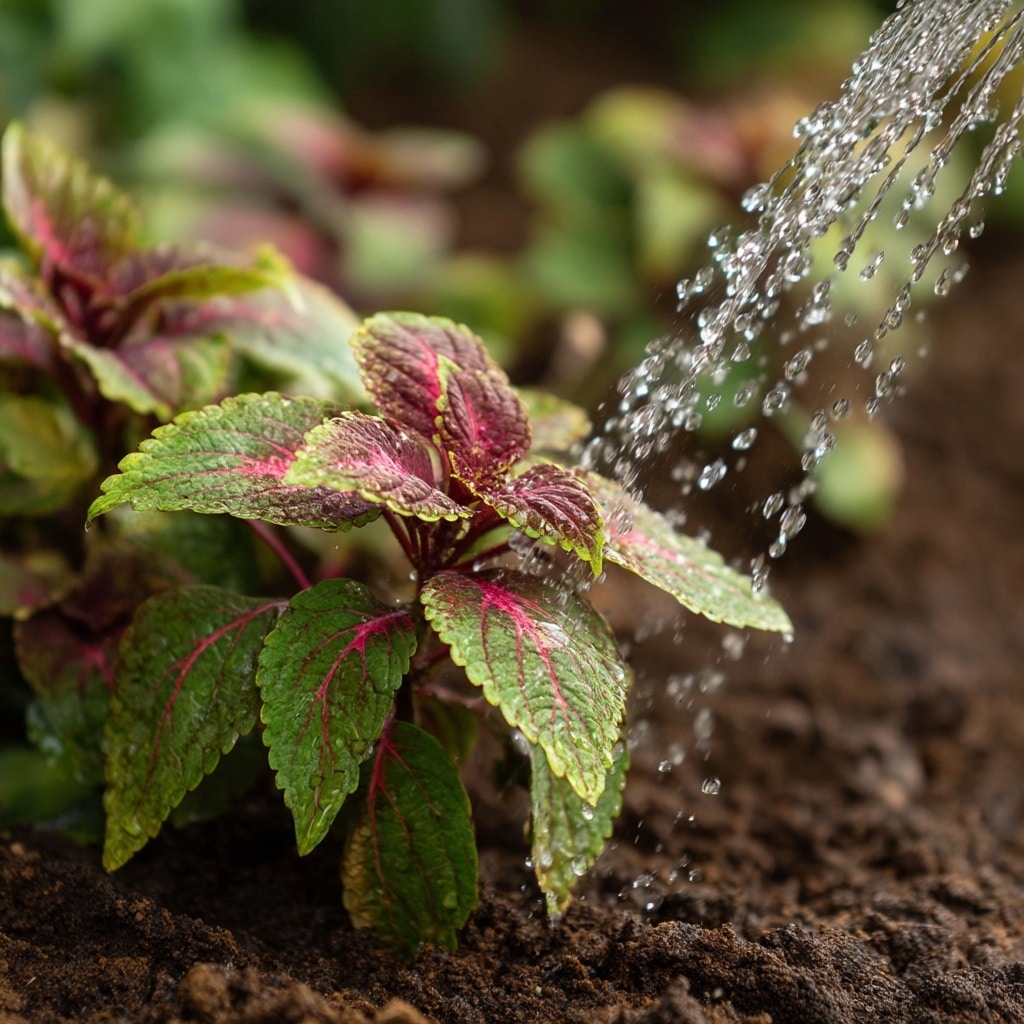
Coleus plants prefer consistently moist soil, but they don’t like to sit in water. The key is balance—water when the top inch of soil feels dry to the touch. Letting them dry out completely can lead to droopy leaves and stunted growth, while overwatering may cause root rot.
For outdoor plants, morning watering is best, giving foliage time to dry before cooler evening temps. During hot weather, you may need to water daily, especially for container-grown coleus. Be sure containers have proper drainage holes to avoid soggy soil.
Indoors, coleus needs less frequent watering, but keep humidity in mind. Dry indoor air can stress the plant. Use a humidifier or a pebble tray if your home is particularly dry, especially during winter.
To keep foliage vibrant and growth steady, maintain even moisture throughout the growing season. A good rule: moist, not muddy.
Temperature & Humidity
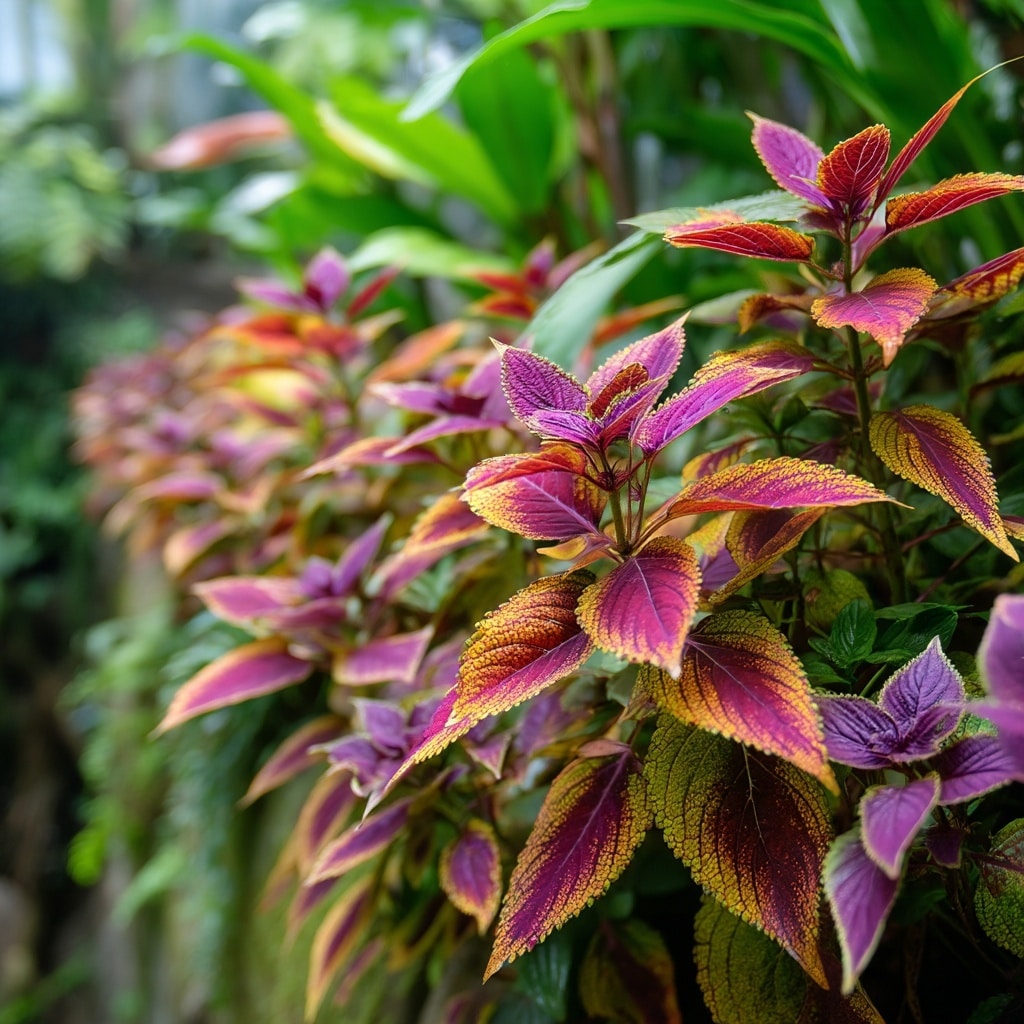
As tropical natives, coleus plants flourish in warm temperatures and high humidity. They grow best when daytime temperatures stay between 70°F and 85°F (21°C to 29°C). Anything below 50°F (10°C) can cause damage, especially prolonged cold or sudden drops.
In USDA hardiness zones 10 and 11, coleus can be grown outdoors year-round. In cooler climates, treat them as annuals or overwinter them indoors to extend their life.
Humidity plays a major role in keeping coleus happy—especially indoors. Dry air can cause browning leaf edges and stunted growth. Misting the leaves occasionally, placing the pot near a humidifier, or using a pebble tray filled with water are effective ways to boost humidity levels.
If your coleus is outdoors in summer and you’re experiencing a heatwave, consider moving container plants to a shadier, cooler area in the afternoon to prevent stress.
Soil Requirements
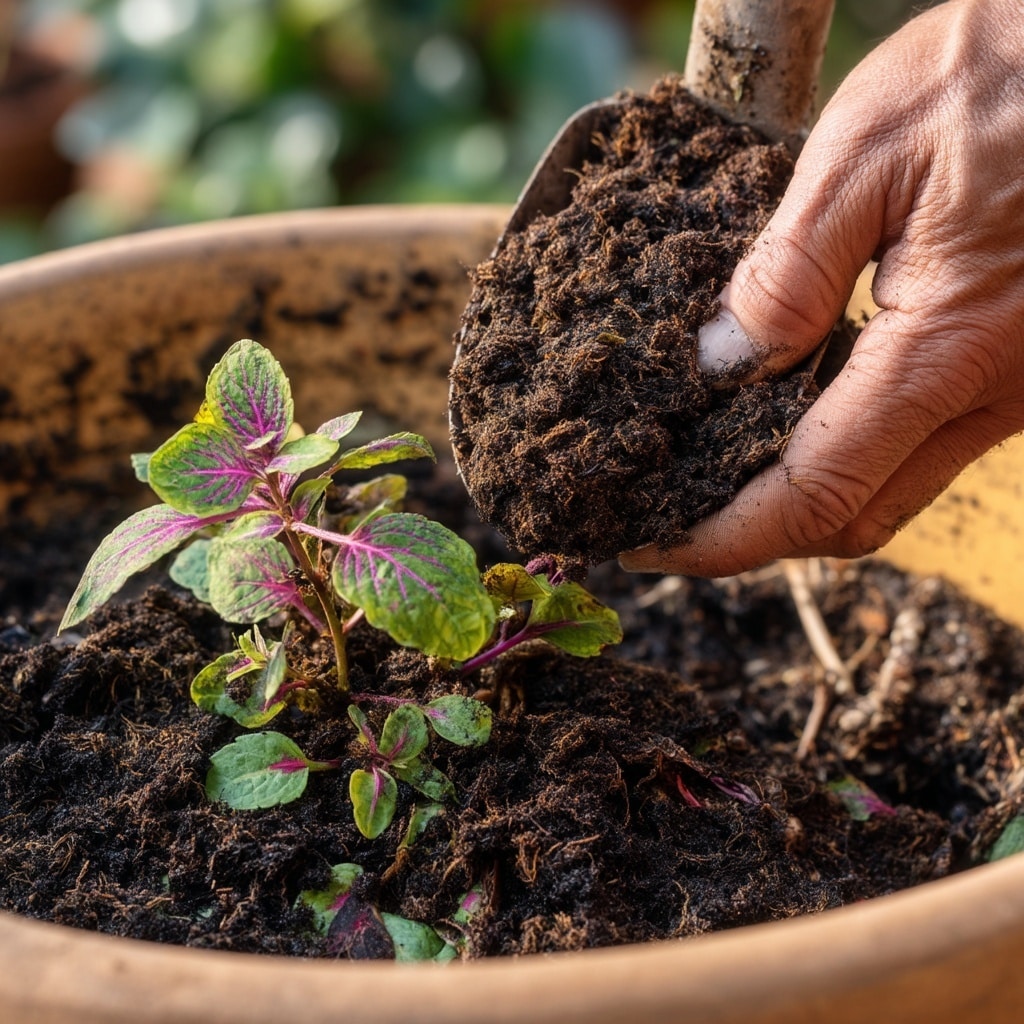
Coleus plants thrive in rich, well-draining soil that holds moisture without becoming soggy. A loose, fertile mix with plenty of organic matter—like compost or peat—is ideal for promoting strong root development and vibrant foliage.
For in-ground planting, work organic compost into the soil before transplanting to improve both structure and drainage. If your soil is heavy clay or tends to stay wet, consider raised beds or containers to prevent root rot.
When growing coleus in pots, use a high-quality potting mix designed for houseplants or annuals. Avoid garden soil, as it can compact in containers and reduce drainage. Adding perlite or pine bark fines can improve aeration.
Good drainage is essential. Whether indoors or out, always choose containers with drainage holes to prevent water from pooling at the bottom, which can lead to fungal issues.
Fertilizer Tips
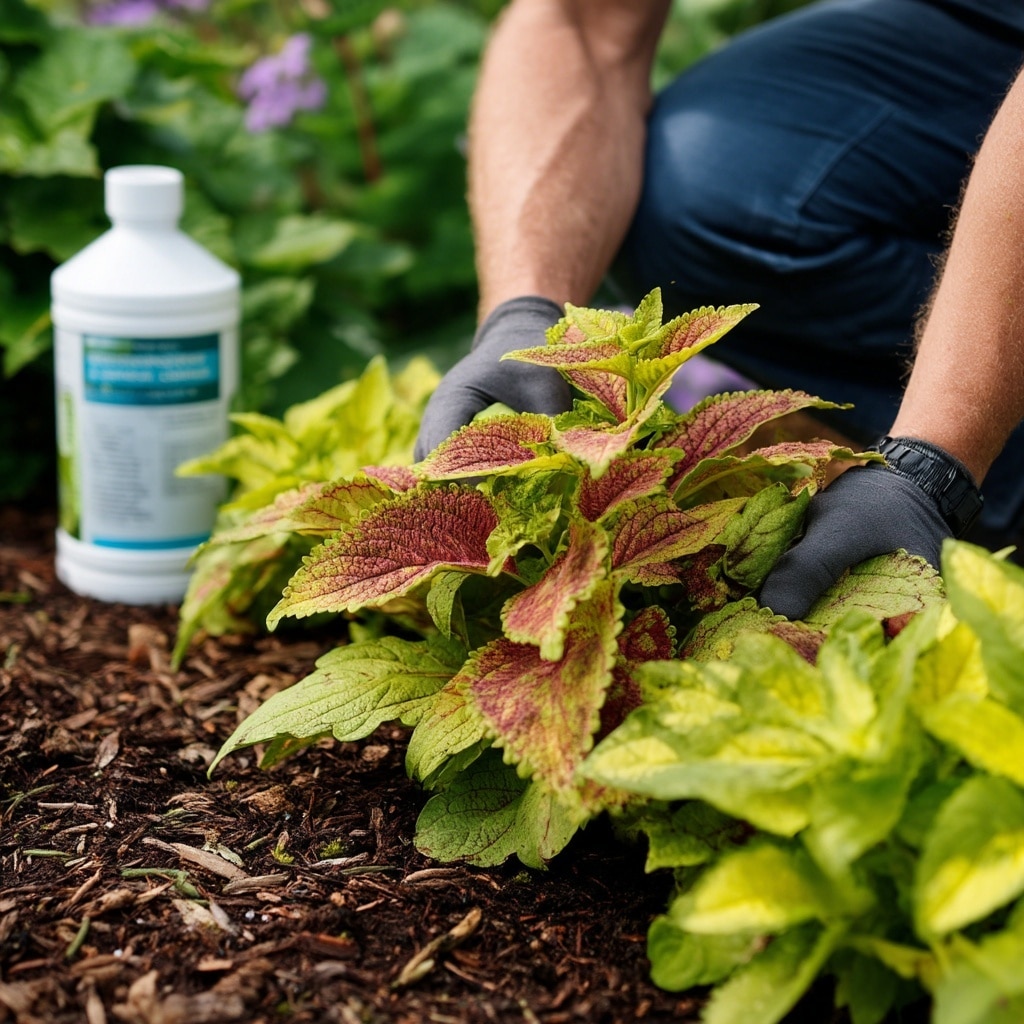
Coleus plants benefit from regular feeding to support their fast growth and bold leaf coloration. A balanced, all-purpose fertilizer—such as a 10-10-10 or 20-20-20 formula—works well when applied monthly during the active growing season (spring through early fall).
Start by mixing a diluted dose into the soil at planting time, especially for containers or poor native soil. After that, feed once every 4 to 6 weeks to keep foliage lush and healthy.
Avoid using fertilizers high in phosphorus (the middle number), which encourages flowering. Since coleus is grown primarily for its leaves, flowering is often discouraged to keep the plant focused on leaf production. If flowers do appear, pinch them off to maintain the plant’s energy for foliage growth.
Over-fertilizing can cause legginess or dull leaf color, so stick to a light, consistent feeding schedule rather than heavy doses.
Common Pests & Problems

Coleus plants are relatively low-maintenance, but like any garden plant, they can occasionally run into trouble. Most issues stem from improper watering or poor air circulation.
Common Problems:
- Root rot: Often caused by overwatering or poor drainage. Always check soil moisture before watering again.
- Leggy growth: Usually due to low light or lack of pruning. Pinch back stems regularly to encourage fullness.
Pests to Watch For:
- Aphids: Tiny green or black insects that cluster on stems and undersides of leaves.
- Spider mites: Microscopic pests that leave fine webbing and stippling damage on foliage.
- Whiteflies: Small white flying insects that can cause leaf yellowing and stunted growth.
To manage pests, rinse affected plants with a gentle spray of water or treat with insecticidal soap or neem oil. Keeping foliage dry and ensuring good airflow helps prevent infestations and disease.
Healthy coleus plants are naturally resilient—so keeping their environment balanced is the best defense.
Growing Coleus From Seed

Starting coleus plants from seed is an easy and rewarding way to grow a wide variety of colors and patterns. While many gardeners buy transplants, growing from seed allows for greater selection and control over timing.
Begin seeds indoors about 8 to 10 weeks before your last expected spring frost. Use a sterile seed-starting mix and lightly press the seeds into the surface—do not cover them, as light is needed for germination. Mist the surface to keep it moist and cover the tray with a humidity dome or plastic wrap to retain warmth.
Keep the temperature around 70°F to 75°F (21°C to 24°C), and seedlings should emerge in 2 to 3 weeks. Once they develop two sets of true leaves, thin them out or transplant into individual containers.
Before moving them outdoors, harden off young coleus plants by gradually exposing them to outdoor conditions over 7–10 days. This reduces transplant shock and helps them adjust to light and temperature changes.
Pruning Tips
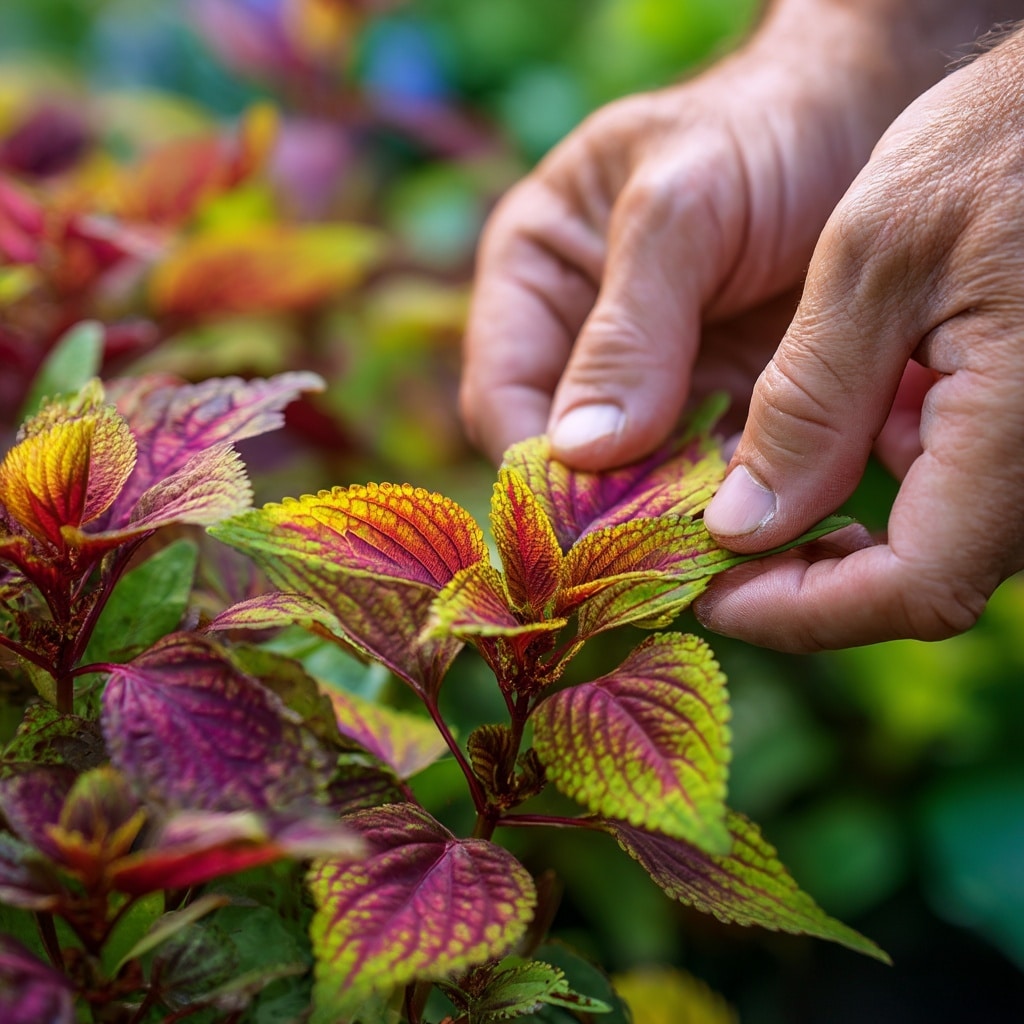
Regular pruning keeps coleus plants full, bushy, and vibrant. Without it, plants can become leggy or top-heavy, especially in containers or shady spots.
The easiest way to prune is by pinching off the top 1–2 inches of new growth just above a leaf node. This encourages side branching and helps the plant maintain a compact shape. Start pinching when the plant is young and continue throughout the growing season.
Remove any flower spikes as soon as they appear. While not harmful, coleus flowers are unimpressive and take energy away from foliage development—the real star of the show. Pinching off blooms helps the plant focus on growing more colorful leaves.
If your coleus becomes too tall or sparse, don’t be afraid to cut it back by up to one-third. It will bounce back quickly with fresh, dense growth, especially during warm weather.
Propagation Methods

Coleus plants are among the easiest garden plants to propagate, making them perfect for sharing or expanding your collection. You can propagate coleus through both stem cuttings and seeds, though cuttings are the faster and more reliable method.
Stem Cuttings:
- Choose a healthy stem and cut 4–6 inches just below a leaf node.
- Remove the lower leaves, leaving only a few at the top.
- Place the cutting in a glass of water in a warm, bright spot (but out of direct sun).
- Roots usually develop within 1–2 weeks.
- Once roots are about an inch long, transplant into potting soil.
Alternatively, you can plant cuttings directly into moist soil and keep humidity high with a clear plastic cover until roots form.
From Seed:
Although slower, seed propagation allows for variety. Start seeds indoors as mentioned earlier and transplant once seedlings are established.
Both methods work well, but stem cuttings let you preserve the exact color pattern and shape of a mature plant.
Repotting Coleus
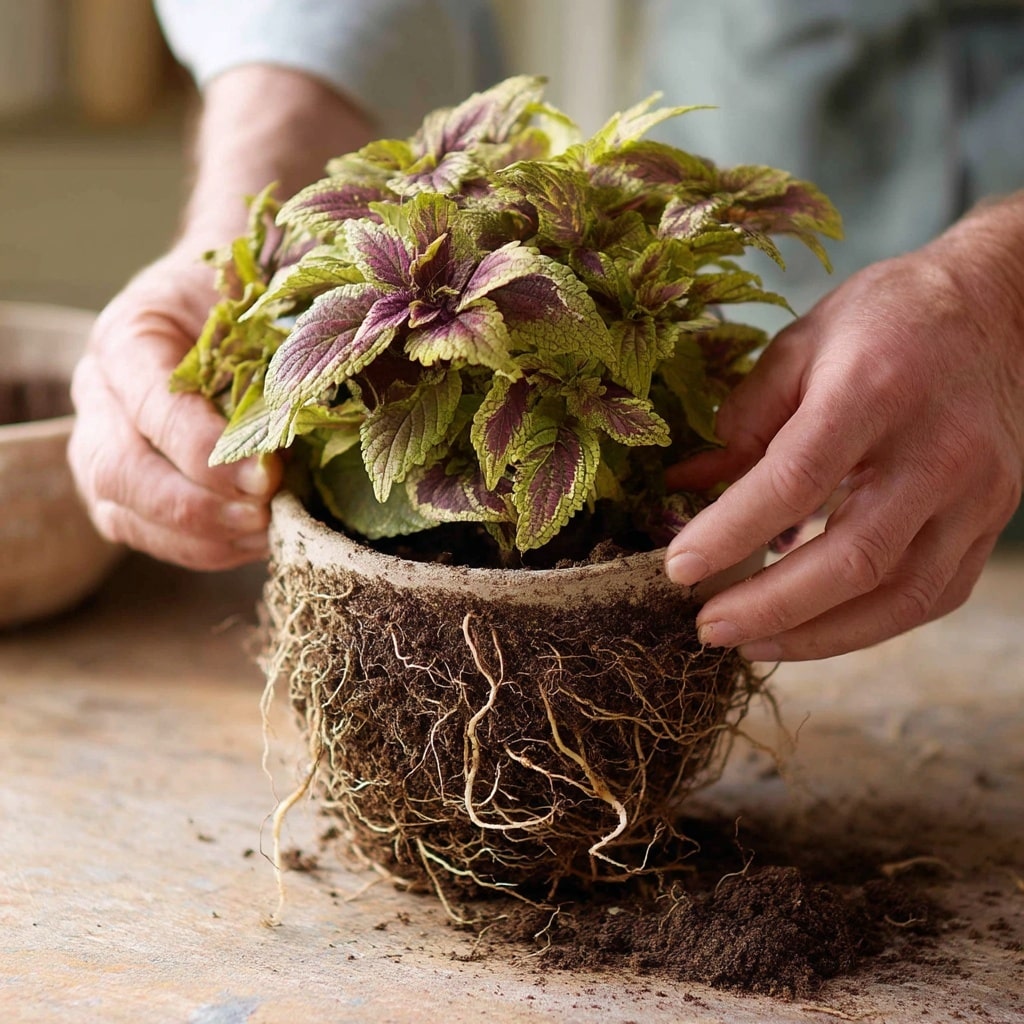
As fast growers, coleus plants often outgrow their containers within a single season. Repotting is essential when roots begin circling the pot or poking out from the drainage holes. A cramped root system can slow growth and lead to stress.
Choose a new container that’s 1–2 inches larger in diameter than the current one, and make sure it has adequate drainage. Use a fresh, high-quality potting mix to give your coleus a nutrient boost and better aeration.
Before repotting, water the plant thoroughly to minimize shock. Gently remove it from its current pot, loosen the root ball slightly, and place it in the new container at the same soil level. Fill in around the roots with soil and water well.
Repotting is also a good time to prune leggy growth and refresh the overall appearance of the plant. With proper care, your coleus will quickly settle into its new home and continue thriving.
Overwintering Tips
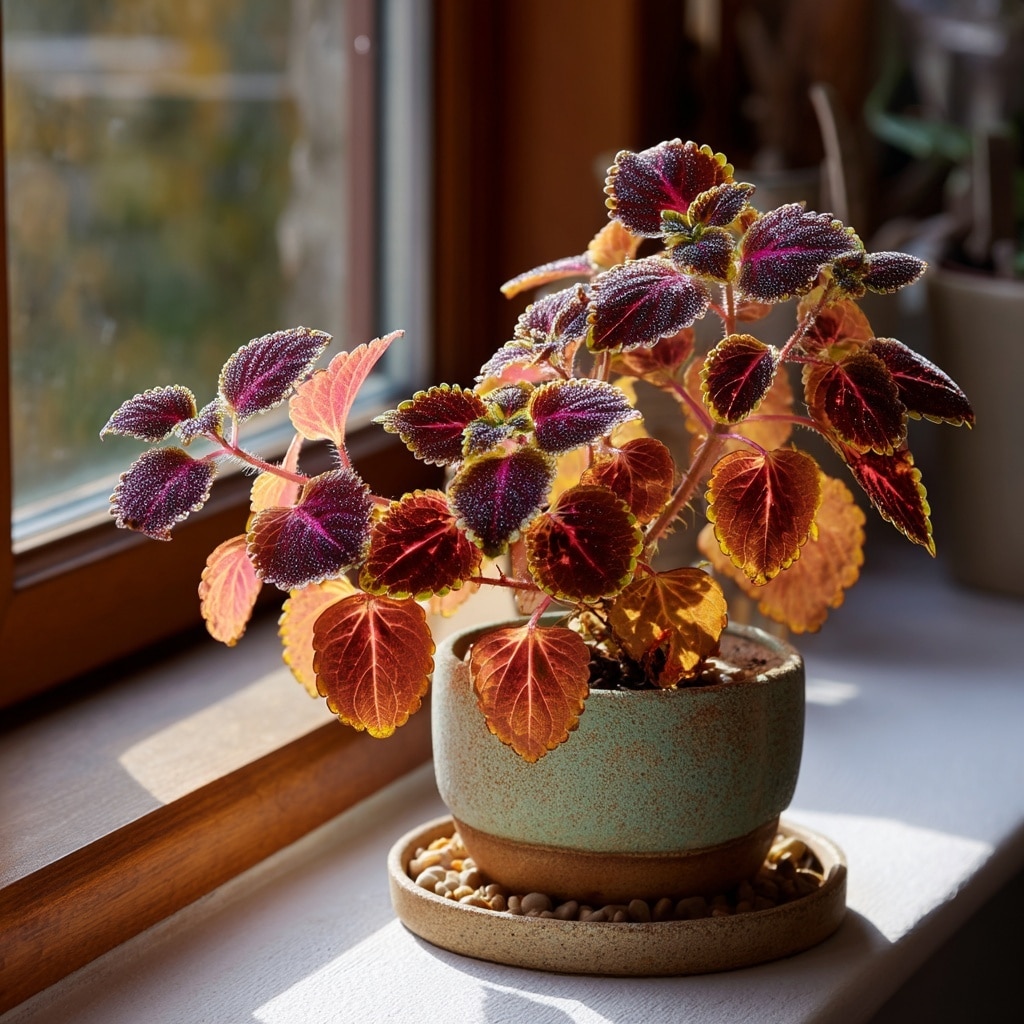
If you live in a region with cold winters, you can still enjoy your coleus plants year after year by overwintering them indoors. Since coleus is highly sensitive to frost, outdoor plants must be brought inside before nighttime temperatures drop below 50°F (10°C).
There are two main options for overwintering:
1. Bring the Whole Plant Indoors:
- Dig up outdoor coleus or bring in container plants before the first frost.
- Place them in a warm, bright location—like a sunny windowsill—with indirect light.
- Keep the soil lightly moist and boost humidity with misting or a pebble tray.
- Trim back any leggy growth to encourage compact form during winter.
2. Take Cuttings:
- Before the frost hits, snip healthy cuttings and root them in water indoors.
- Once rooted, pot them in soil and grow them on a windowsill over winter.
- This method saves space and produces fresh plants for spring.
Whichever approach you choose, overwintering helps keep your favorite varieties alive and ready for another vibrant season outdoors.
Popular Coleus Varieties
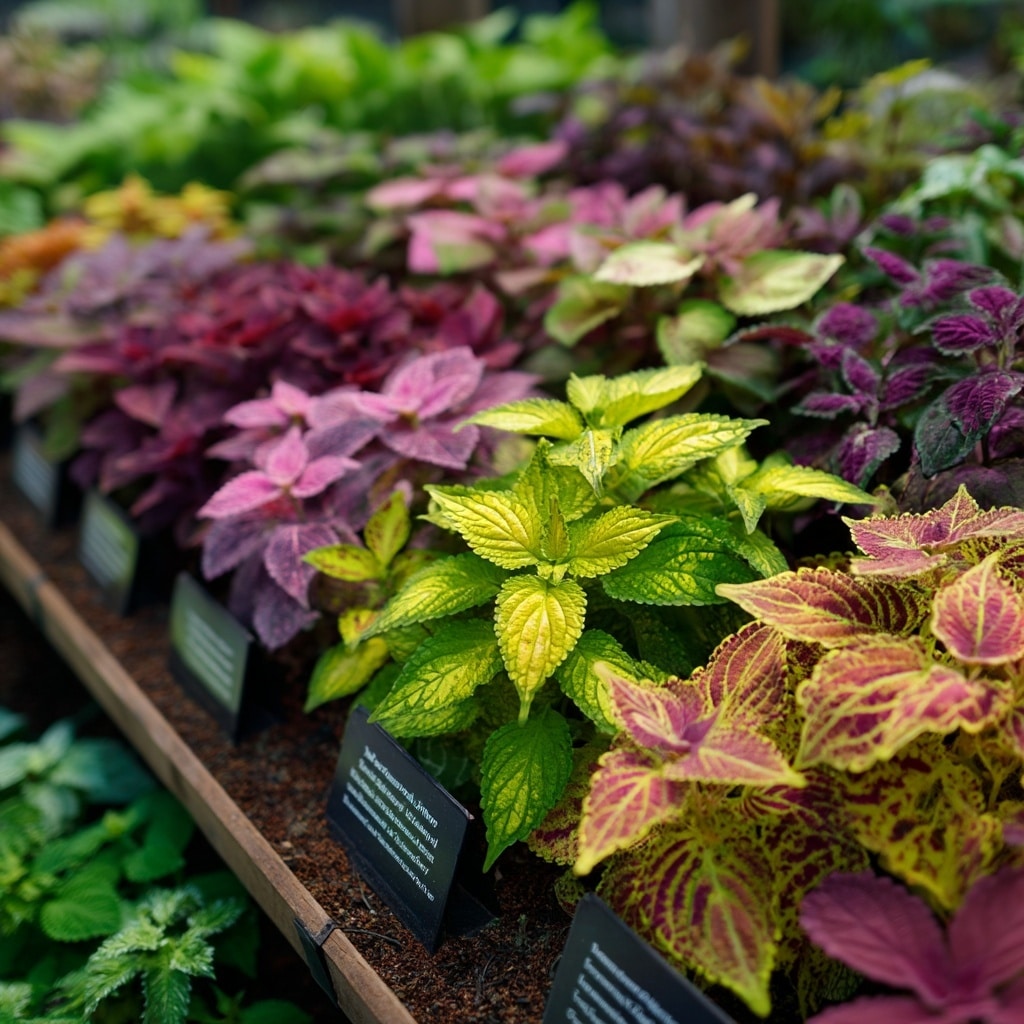
With their endless color combinations and leaf shapes, coleus plants come in dozens of unique cultivars. Whether you’re after bold contrast or subtle elegance, there’s a variety for every garden style.
Here are some standout types worth trying:
- Alabama Sunset – Deep red centers with bright green margins; tolerates more sun than most.
- Dark Star – Striking, nearly black foliage that adds drama to any container or bed.
- Fishnet Stockings – Delicate green leaves veined with burgundy-purple, resembling lace patterns.
- Inferno – Bright orange-red foliage that stands out in both shade and sun.
- Kong Series – Extra-large leaves in a variety of colors; thrives in full shade.
- Red Ruffles – Deep red ruffled leaves edged with lime green.
- Wasabi – Vivid chartreuse leaves with a bold, upright habit; excellent for contrast planting.
Mixing several cultivars can create a living tapestry in containers or garden beds. Just be sure to group varieties with similar light and care requirements.
Frequently Asked Questions
How long do coleus plants live?
Coleus plants are technically tender perennials, but in most regions, they are grown as annuals due to their sensitivity to frost. Outdoors, they last one growing season unless brought inside. Indoors or in warm climates, a well-cared-for coleus can live for several years with proper pruning and repotting.
Can coleus be grown indoors?
Yes! Coleus makes an excellent houseplant. Choose a bright spot with indirect light and keep the soil consistently moist but not soggy. Indoor coleus appreciates added humidity—misting or using a pebble tray works well. With regular pinching and occasional fertilizing, it will thrive all year long.
Conclusion
Coleus plants are a gardener’s dream: easy to grow, bold in color, and versatile enough for containers, garden beds, or indoor spaces. With just a little attention to light, moisture, and pruning, these vibrant foliage plants will reward you with nonstop color from spring through fall—or even year-round indoors.
Whether you’re just starting out or expanding your collection, following this care guide will help you get the most out of your coleus plants season after season.

